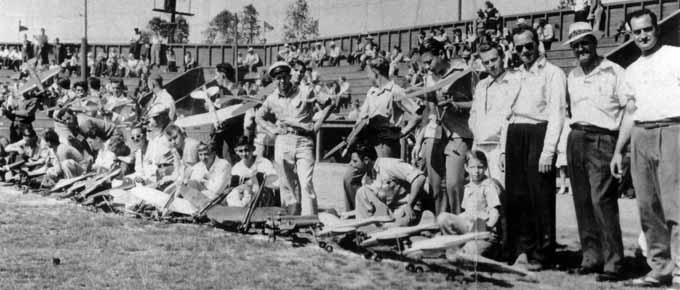
Pre-War Fireball Story
by A-J Historian Frank Macy
This photo of Jim Walker and the new Portland Fireball Club was taken at the club's flying field which was the Portland International Speedway, July 1940. Count the Fireballs. That was the only plane on the market that was a U-Control airplane. None of the other manufacturers were yet there. Stanzel Sharks were available but you had to completely build them from a kit and they were not U-Control, but Stanzel G-Line which didn't offer reliable control. The Fireball offered a pre-shaped fuselage, just sand it and paint it and simple sheeted wing, and tail feathers. They said you could build it and fly it in six hours.
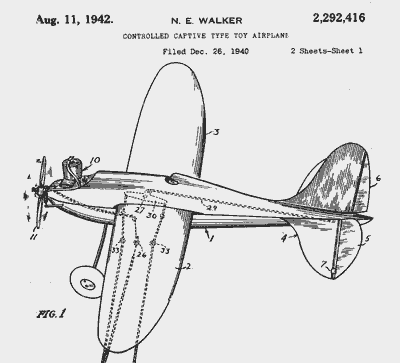 |
Jim Walker filed the U-Control system patent in 1940.
Note the early ignition speed control as a third line. |
The summer of 1940 brings to mind many events from the pages of history. The most obvious was the daily news of a world preparing for war, with some nations already at battle. U.S. involvement at the time was simply that of supplier to its allies. This of course would change in another 16 months with the attack on Pearl Harbor. Another event occurred in the summer of 1940 which was much more pleasant, but which few people today realize. A man by the name of Jim Walker stunned the modeling world with the introduction of U-Control. In his usual dramatic manner, Jim disrupted the National Model Airplane meet in Chicago by flying his new Fireball (with U-Control) powered by a new Ohlsson .23 engine. Officials of the meet were anything but pleased with what they considered a rude disruption of the event. On the other hand, contestants and spectators quickly gathered around to watch this fantastic flight demonstration of a gas powered model airplane flying on long lines in a big circle. The crowd was awestruck, and Jim was delighted.
This was the first time many of them had actually witnessed model flight controlled by lines. Except for early experiments in Radio Control, all flying was categorized as Free Flight. Many were impressed and anxious to try this new "U-Control" system which looked so easy and obviously a lot of fun. A few were skeptical though, convinced that it would be as exciting as flying a brick on a string. Time would tell.
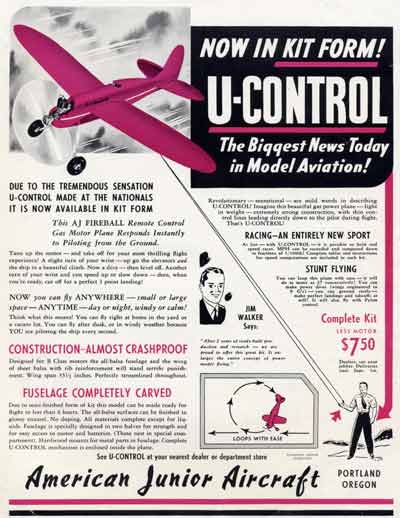 |
|
First full page ad in Model Airplane News - September 1940. Click for larger image. |
|
Following the NATS, a full page ad appeared in the Sept. 1940 issue
of Model Airplane News introducing the new A-J Fireball with U-Control.
The promise was that "You can now fly anywhere, even in your own back
yard," performing stunts, loops, hedge-hopping, etc. In addition, the ad
said you could "build it and fly it in 6 hours." The kit featured an entirely
new concept in model construction with a fully carved and shaped balsa
fuselage, wing sheet covering of balsa cut to shape, and all parts ready
for immediate assembly. The American Junior Aircraft factory was soon
swamped with orders, and the world's first prefabricated "U-Control" kit was on its way to making history.
Although it was December of 1940 before Jim applied for his patent
for U-Control with the U.S. Patent Office, his experimentation with Control
Line flight began many years before. The following is from "U-Control
History and Hints," by N.E. "Jim" Walker: "The history of U-Control dates back to the '20s when I demonstrated
rubber powered models in department stores. Due to restrictions against
Free Flight indoors, I developed a tether flight that successfully
demonstrated the take off and climbing ability of a model by attaching
a line to the wing in the correct position to assure lateral and longitudinal
stability. With the advent of gasoline powered flight in the early '30s, I
experimented with many types of control and became convinced that the
average modeler would like to fly his model from the ground in a limited area.
Also, the fun of running the motor continuously would have very strong
appeal. Some models used a single line, others as many as five lines."
For historical clarification, it should be pointed out that the term"Control-Line" is generic. The names "G-Line, Mono-Line, Flight-Control
and U-Control, etc.," are different trademarked systems in the Control-Line
category.
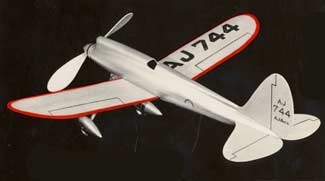 |
A-J 744 Racer influenced the Fireball design - 1937 |
Of the many different models Jim designed and tested in his control line
experiments, the one which became the inspiration for the Fireball design
was the A-J 744 Racer of 1931. It looked like a mixture of DeHaviland,
Curtiss and Howard "Pete" all thrown together. With its beautifully formed
all balsa monococque fuselage, one could also detect the influence of
Lockheed. The 744 was much too small for gas powered flight, but by
enlarging the wing to 36 inches sufficient area for flight was achieved.
The wing construction for the time was quite unique, consisting of top
and bottom 1/16 inch balsa sheets cut to shape. The bottom sheet was printed
for rib locations and edge bevel line. After ribs were glued in place and
bottom edge bevelled, the top sheet was glued on. Wing halves were then
joined together at proper dihedral and the joint reinforced with a 3 inch
band of crinoline generously saturated with glue. This formed a very light
but extremely strong wing, quickly.
The major developmental problem was the fuselage. Jim as a pioneer
in the Ready-To-Fly concept and wanted to apply that technology to his
new Control Line model. The standard stick and silk (or tissue) method
was too slow and required great skill and patience of the builder. The other
consideration being that the fuselage was oval in shape and had many curves which would make it extremely difficult to build in the traditional way. After much experimentation, the idea of a full carved fuselage emerged. Test models were carved by hand, assembled and flown in 1937. It was soon discovered that the most logical answer was a two piece horizontally split fuselage consisting of an upper and lower shell. This allowed a midwing configuration, plus the advantage of engine, accessories and the U-Control mechanism mounted in the lower shell. The top piece merely went along for the ride. The whole airplane was designed in such a way that it would simply pop apart upon impact, and quickly reassembled with rubber bands, with little or no damage whatsoever.
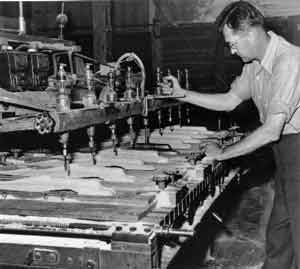 |
Bill Walker at the Fireball router carving machine, pre-war.
|
With the design of the airplane finalized, the Company purchased a large
8 spindle carving machine from a furniture manufacturer. Aluminum master
plugs were cast for the exterior and interior shape of the fuselage. Carving
eight at a time required sixteen minutes, a total of sixty four minutes
to complete eight rough carved fuselage sets. The airplane was produced
in batches of 96, which required 2 two ton trucks per day to haul the scrap
balsa away.
When the new Ohisson .23 came on the market in 1938, Jim installed one
in the (now named) FIREBALL. It was love at first flight, and quickly
became known as THE engine for the FIREBALL. It appeared in all the
early ads and box labels, and was the engine used when the airplane was
introduced at the NATS in Chicago, 1940. The assembly instructions gave
details on how to vary engine speed, using a third line to retard or advance
the ignition timer. The purpose of this was to allow smooth, realistic
take-off and landing. The power output was sufficient to allow the new
thrill of controlled loops, zooms, and hedge-hopping. Anyone who had
guts enough to perform any of those feats, particularly a loop, became
an instant hero to observers. Can you imagine what the crowd thought
as they watched Jim perform 27 consecutive loops? The thrill of U-Control
flight with the FIREBALL challenged the imagination of thousands, and
sold alot of FIREBALL Kits and Ohlsson .23 engines.
Many new U-Control clubs started forming around the country, and soon
some of the guys were modifying their FIREBALLS to various configurations
for racing and speed. An Ohisson 60, a Super Cyclone or Bunch
Tiger Aero soon took the FIREBALL to the blazing speeds of 50, 60,
even 70 MPH. Thus was born not only stunt, but speed and racing with
U-Control. By this time in history, other things in world events were also
heating up. It was almost December of 1941.
As America entered World War n the nation was shocked into the reality
of sacrifice. Almost all vital necessities and goods became rationed, or
war priority goods unavailable to the public. The Model Hobby Industry
was also severely affected as balsa wood, metals, paint and petroleum products
were classified as "War Priority" items. Model Kit Manufacturers
changed to cardboard, paper and hardwood veneer substitutes for balsa.
Model engines became unavailable as their shop facilities were utilized
to produce war products.
American Junior Aircraft Company however was one of the few model
manufacturing firms that continued to produce balsa airplanes with original
metal parts as needed. The reason was simple enough.. .A-J now produced
airplanes for the War Department. For example, the Folding Wing Interceptor
became a catapult launched Target Drone for machine gun practice.
Hundreds of thousands were produced for this purpose. The FIREBALL
also became a free flying Target Drone for the NAVY. Painted in bright
International Orange, they were launched from ships at sea and shot out
of the air by machine guns and 20mm guns. In addition, American Junior
manufactured Radio Controlled Target Drones with 14 foot wing span,
powered by twin cylinder Righter engine of 6 H.P. with contra-rotating props.
During the war, production needs often demanded 3 shifts per day at the factory.
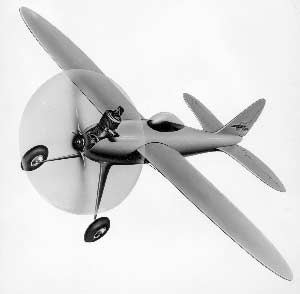 When the war ended, a new FIREBALL had been designed and was
ready to go. It was called the FIREBALL "Advancer," the first of the "Bubble Tops." In truth, the only thing that changed was the fuselage
top and the rudder. The post-war FIREBALL is the subject of a future
article.
When the war ended, a new FIREBALL had been designed and was
ready to go. It was called the FIREBALL "Advancer," the first of the "Bubble Tops." In truth, the only thing that changed was the fuselage
top and the rudder. The post-war FIREBALL is the subject of a future
article.
© 1990 Frank D. Macy
Home | Jim Walker | FireWire | Air Mail | Workshop | Short Takes | Contact Us
